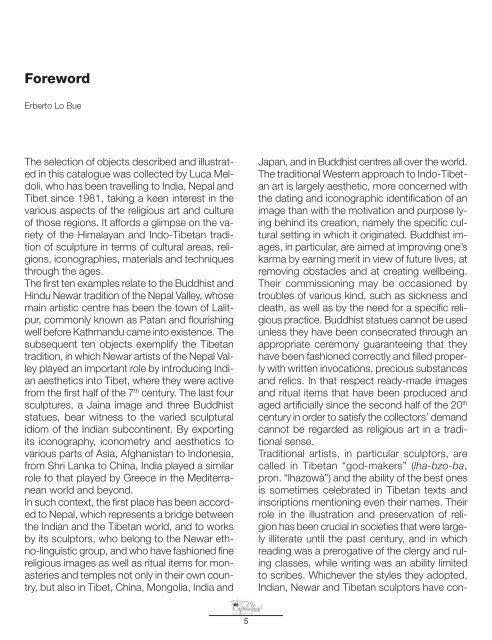Images of Devotion - capriaquar.it
Images of Devotion - capriaquar.it
Images of Devotion - capriaquar.it
Create successful ePaper yourself
Turn your PDF publications into a flip-book with our unique Google optimized e-Paper software.
Foreword<br />
Erberto Lo Bue<br />
The selection <strong>of</strong> objects described and illustrated<br />
in this catalogue was collected by Luca Meldoli,<br />
who has been travelling to India, Nepal and<br />
Tibet since 1981, taking a keen interest in the<br />
various aspects <strong>of</strong> the religious art and culture<br />
<strong>of</strong> those regions. It affords a glimpse on the variety<br />
<strong>of</strong> the Himalayan and Indo-Tibetan trad<strong>it</strong>ion<br />
<strong>of</strong> sculpture in terms <strong>of</strong> cultural areas, religions,<br />
iconographies, materials and techniques<br />
through the ages.<br />
The first ten examples relate to the Buddhist and<br />
Hindu Newar trad<strong>it</strong>ion <strong>of</strong> the Nepal Valley, whose<br />
main artistic centre has been the town <strong>of</strong> Lal<strong>it</strong>pur,<br />
commonly known as Patan and flourishing<br />
well before Kathmandu came into existence. The<br />
subsequent ten objects exemplify the Tibetan<br />
trad<strong>it</strong>ion, in which Newar artists <strong>of</strong> the Nepal Valley<br />
played an important role by introducing Indian<br />
aesthetics into Tibet, where they were active<br />
from the first half <strong>of</strong> the 7 th century. The last four<br />
sculptures, a Jaina image and three Buddhist<br />
statues, bear w<strong>it</strong>ness to the varied sculptural<br />
idiom <strong>of</strong> the Indian subcontinent. By exporting<br />
<strong>it</strong>s iconography, iconometry and aesthetics to<br />
various parts <strong>of</strong> Asia, Afghanistan to Indonesia,<br />
from Shri Lanka to China, India played a similar<br />
role to that played by Greece in the Med<strong>it</strong>erranean<br />
world and beyond.<br />
In such context, the first place has been accorded<br />
to Nepal, which represents a bridge between<br />
the Indian and the Tibetan world, and to works<br />
by <strong>it</strong>s sculptors, who belong to the Newar ethno-linguistic<br />
group, and who have fashioned fine<br />
religious images as well as r<strong>it</strong>ual <strong>it</strong>ems for monasteries<br />
and temples not only in their own country,<br />
but also in Tibet, China, Mongolia, India and<br />
5<br />
Japan, and in Buddhist centres all over the world.<br />
The trad<strong>it</strong>ional Western approach to Indo-Tibetan<br />
art is largely aesthetic, more concerned w<strong>it</strong>h<br />
the dating and iconographic identification <strong>of</strong> an<br />
image than w<strong>it</strong>h the motivation and purpose lying<br />
behind <strong>it</strong>s creation, namely the specific cultural<br />
setting in which <strong>it</strong> originated. Buddhist images,<br />
in particular, are aimed at improving one’s<br />
karma by earning mer<strong>it</strong> in view <strong>of</strong> future lives, at<br />
removing obstacles and at creating wellbeing.<br />
Their commissioning may be occasioned by<br />
troubles <strong>of</strong> various kind, such as sickness and<br />
death, as well as by the need for a specific religious<br />
practice. Buddhist statues cannot be used<br />
unless they have been consecrated through an<br />
appropriate ceremony guaranteeing that they<br />
have been fashioned correctly and filled properly<br />
w<strong>it</strong>h wr<strong>it</strong>ten invocations, precious substances<br />
and relics. In that respect ready-made images<br />
and r<strong>it</strong>ual <strong>it</strong>ems that have been produced and<br />
aged artificially since the second half <strong>of</strong> the 20 th<br />
century in order to satisfy the collectors’ demand<br />
cannot be regarded as religious art in a trad<strong>it</strong>ional<br />
sense.<br />
Trad<strong>it</strong>ional artists, in particular sculptors, are<br />
called in Tibetan “god-makers” (lha-bzo-ba,<br />
pron. “lhazowà”) and the abil<strong>it</strong>y <strong>of</strong> the best ones<br />
is sometimes celebrated in Tibetan texts and<br />
inscriptions mentioning even their names. Their<br />
role in the illustration and preservation <strong>of</strong> religion<br />
has been crucial in societies that were largely<br />
ill<strong>it</strong>erate until the past century, and in which<br />
reading was a prerogative <strong>of</strong> the clergy and ruling<br />
classes, while wr<strong>it</strong>ing was an abil<strong>it</strong>y lim<strong>it</strong>ed<br />
to scribes. Whichever the styles they adopted,<br />
Indian, Newar and Tibetan sculptors have con-


